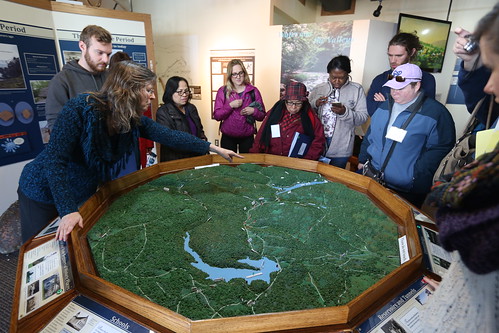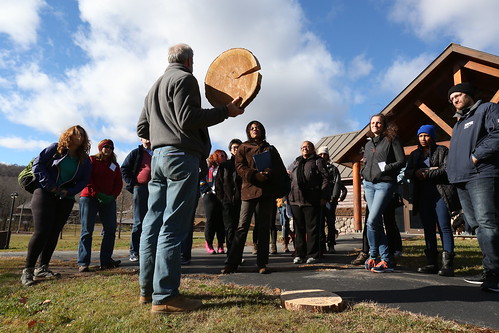FOR IMMEDIATE RELEASE 16-117 November 17, 2016 deppressoffice@dep.nyc.gov, (845) 334-7868 New York City Teachers Learn About Water Supply, Forests and Streams During Watershed VisitMore than 50 educators participated in watershed tour through Sullivan and Ulster countiesCaption: More than 50 educators from New York City participated in a tour of the City’s water supply system and its watershed on Nov. 11. The teachers learned about the water supply and its history, forests, stream management and watershed protection during their tour through Sullivan and Ulster counties. The tour included a visit to the Time and the Valleys Museum in Grahamsville. Above, museum director Donna Steffens uses a diorama to explain how communities in the Catskills were removed or relocated to make way for the City’s reservoirs, dams and aqueducts. The teachers’ visit was organized by DEP’s education office and funded by the Watershed Agricultural Council. It included educators from all five boroughs of New York City, and the east-of-Hudson and west-of-Hudson watersheds. Caption: More than 50 educators from New York City participated in a tour of the City’s water supply system and its watershed on Nov. 11. The teachers learned about the water supply and its history, forests, stream management and watershed protection during their tour through Sullivan and Ulster counties. The tour included a visit to the model forest at Frost Valley YMCA in Claryville. Karl VonBerg, a forester at the Watershed Agricultural Council, used the cross-section of a tree to demonstrate that land cover and precipitation can affect trees’ growth rate. VonBerg also discussed how forests help purify water as it moves into the City’s water supply reservoirs. The teachers’ visit was organized by DEP’s education office and funded by the Watershed Agricultural Council. It included educators from all five boroughs of New York City, and the east-of-Hudson and west-of-Hudson watersheds. DEP manages New York City’s water supply, providing more than one billion gallons of high quality water each day to more than 9.5 million New Yorkers. This includes more than 70 upstate communities and institutions in Ulster, Orange, Putnam and Westchester counties who consume an average of 110 million total gallons of drinking water daily from New York City’s water supply system. This water comes from the Catskill, Delaware, and Croton watersheds that extend more than 125 miles from the City, and the system comprises 19 reservoirs, three controlled lakes, and numerous tunnels and aqueducts. DEP has nearly 6,000 employees, including almost 1,000 scientists, engineers, surveyors, watershed maintainers and other professionals in the upstate watershed. In addition to its $70 million payroll and $157 million in annual taxes paid in upstate counties, DEP has invested more than $1.7 billion in watershed protection programs—including partnership organizations such as the Catskill Watershed Corporation and the Watershed Agricultural Council—that support sustainable farming practices, environmentally sensitive economic development, and local economic opportunity. In addition, DEP has a robust capital program with nearly $14 billion in investments planned over the next 10 years that will create up to 3,000 construction-related jobs per year. For more information, visit nyc.gov/dep, like us on Facebook, or follow us on Twitter. | ||

